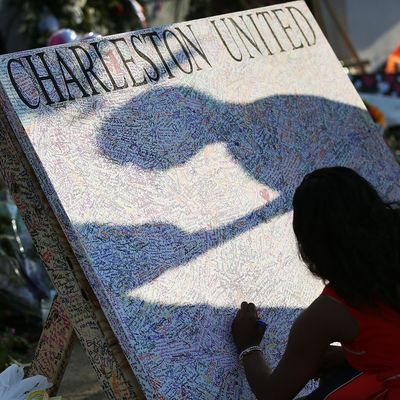
“I mean, this thing is big, it has shocked people,” says Donald West, who teaches history at Trident Technical College just outside of Charleston. “Because the church was a real symbol.”
Wednesday marked seven days after nine people were murdered during Bible study in the basement of the historic Emanuel African Methodist Episcopal Church, which everyone in the black community in Charleston, South Carolina, calls “Mother Emanuel.” That night, the church, founded in 1816 by free African-Americans, would hold its next weekly Bible study, and that afternoon I’m sitting in West’s cluttered office, as he speaks with a contained explanatory edge. His bookcase is crowded with titles like White Supremacy, Many Thousands Gone, Upheaval in Charleston, and Cornel West’s Race Matters; a DVD of Viva Mandela! is on his desk, and a large green, yellow, and red memorial ribbon of the sort people stick on the back of their cars is affixed to his filing cabinet. He’s a Civil War reenactor, he tells me (54th Massachusetts), and today he’s wearing an elaborately embroidered dashiki a friend brought back from Gambia. “I knew three of the people that were killed. I had been to the church many times,” he says. “It was not just an attack on people, it was an attack on history.”
Charleston is a city of co-habitating histories. In many ways, the cozily picturesque promise of olden times is how it makes its living these days: After years of carefully plotted gentrification, the gussied-up old part of the city, called the Peninsula, preens with touristic Antebellum middlebrow hospitality glamour. Today it is perhaps the only place in the world where, at the corner of Market and Meeting streets, a Gucci boutique sits within the line of sight of the templelike 19th-century structure that houses the local coven of the Daughters of Confederacy. About the groundswell of support for removing the Confederate flag from state buildings in the wake of the shooting, West says dryly, “I’ll believe it when it happens.”
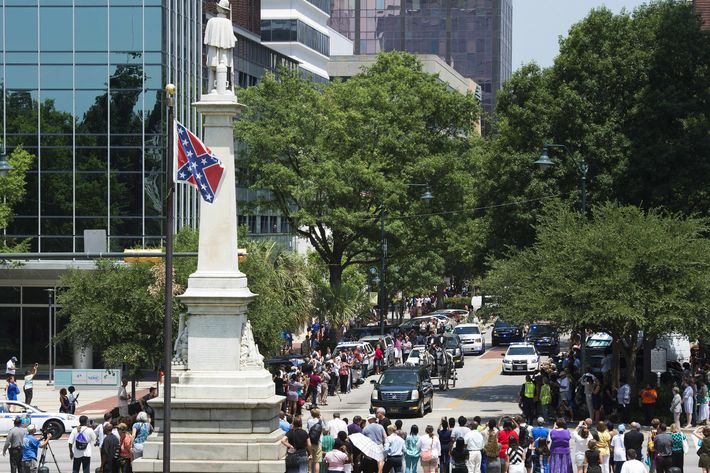
On Friday President Obama will speak at the memorial service for the pastor of Mother Emanuel, Reverend Clementa Pinckney, at the College of Charleston’s TD Arena. Streets are being closed off for the arrival of the president along with the First Lady and Vice-President Biden. Aside from the fate of the Confederate flag, it’s all anybody has been talking about. “I think a lot of African-Americans who supported and voted for the president, and there are a lot — and I would say a significant percentage of whites too — no one expected the race and racial reaction that we continue to see as a result of his tenure in office,” says West.
I’d been introduced to West by Henry Darby, one of Charleston’s three (of nine) African-American councilmen. A year earlier Darby made the local news for his attempt to convince the famous local military college, the Citadel, to take down its Confederate flag (which was unsuccessful). I’d hoped to meet him at the church that Wednesday, but he told me he was still too shaken to go by there and hadn’t been since the night of the massacre. “I’ve basically withdrawn into a shell,” Darby tells me on the phone.
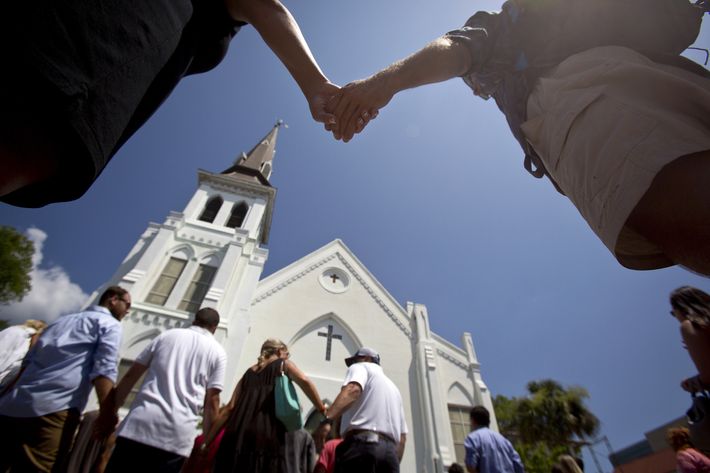
“Charleston is a holy city, it’s almost like a thesis and antithesis,” he says. This nickname, the Holy City, comes from the thicket of steeples that crowd its resolutely antebellum skyline. But few of the white churches attached to those steeples, he points out, ever chose to crusade against the flag and what it represented. “What has disappointed me most is the silence of the white churches,” he says. “Every Sunday they preach God and Jesus Christ and the brotherhood of man,” all “pious irrelevancies” he observes. “And they never took the position.”
Of the remarkable, immediate, forgiving response of the victims’ families, he says, “it’s nothing new in the African-American community: We have always said ‘we forgive you’ to the people who torment us. But what have we done to deserve this type of treatment? What have we done? I don’t see anything other than not wanting to not be in bondage.”
“I respect what has happened in terms of changing hearts and minds,” he says. But then he pauses, before focusing on Governor Nikki Haley and Senator Tim Scott, the local leaders whose movement on the issue really signaled that the ground had shifted. “They were pressured to do this. It’s not of their own accord. They were forced to do this. I can bet you, when it comes down to the final analysis — once business speaks they listen.” He sighs. “Yes, we have come together, but our community as a whole — there’s always been this negative peace as opposed to positive tension,” he says. “I would prefer the latter. We need to have discussions, openly. This negative peace needs to go. I would prefer positive tension, anytime.”
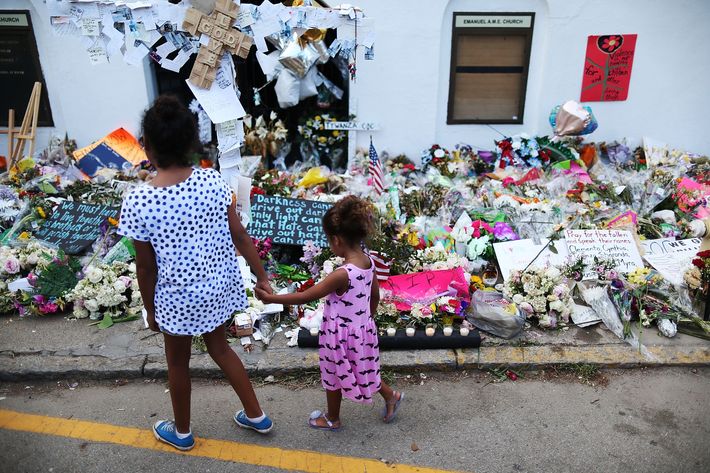
That night the church held Bible study in the same basement where the killings occurred, this time with a policeman guarding the room and to a crowd of nearly 200. The topic was “The Power of Love.”
“Last week,” the interim Pastor Norvel Goff said, “dark powers came over Mother Emanuel.” There was call-and-response assent — lots of “amens” — and he called them to not hate in their hearts, “not because we are weak, but because we are strong.” And they sang.
The area had already become a shrine of Mylar balloons, American flags, heaps of flowers, and posters featuring Biblical exhortations. There were personal notes written in Sharpie on the bark of the tree out front (“love sees no color”), and on a piece of pastel panda bear notepaper tacked to a telephone pole (“Hate has hurt us. Only Love can heal us”). Some people were selling black T-shirts out of a cardboard box for $20 (going to the church, they said) that featured two hands cupping a drawing of the building. Many of the volunteers handing out free cupcakes and bottles of water on the cordoned-off sidewalk in front of the church were white and blonde — sweetly drawled declarations of “God bless” tinkled through the air. And many of those who had come earlier that day to pay tribute — in 90-degree Southern swelterwear — took pictures with their phones or posed for selfies. Because it’s 2015, there was much hashtag-mourning: #CharlestonStrong, #IAmAME.
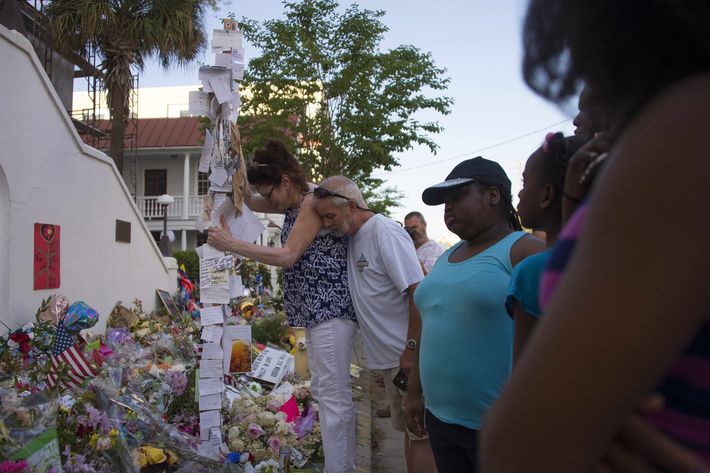
“The sad part about this whole thing is that it took nine people to lose their lives to make this a national issue, and a state issue,” says Teddie Pryor, one of the other African-American members of the county government council. “And now everybody is onboard. Every politician wants to be onboard. Everybody wants to be on the right side of history.”





























